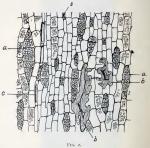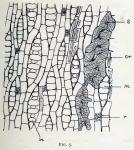Only five species of the genus Tsuga are known; two of these belong to Eastern Asia, one, Tsuga Canadensis, Carriere, is the common hemlock spruce of the Eastern United States; and the other two, Tsuga Mertensiana, Carriere, and Tsuga Pattoniana, Brewer and Watson, are natives of the Pacific Coast of North America. All are trees of large size and graceful habit, and the first four are very closely allied, being so similar in appearance that they are with difficulty distinguished, while the fifth, Tsuga Pattoniana, is somewhat aberrant in its characters, approaching more closely the pines and spruces in its structure
 Tsuga Canadensis is an abundant species in many portions of the Eastern United States and Canada, ranging in its habitat from Nova Scotia to Delaware on the east, extending southward along the Alleghanies to Alabama, and westward along the northern ranges of States and the Canadian border to Minnesota. It is easily distinguished from the coniferous trees with which it is associated, by its small cones, one-half or two-thirds of an inch long, pendulous at the ends of the branches; by the slender, spreading branchlets which have crowded apparently two-ranked leaves along their sides; and by the distinctly petiolate, flattened, linear, denticulate leaves, which are green above and glaucous beneath, and provided with a single resin duct on their dorsal surface. Its trunk is extensively employed for lumber and its bark for tanning purposes. Its pitch, also, which is extracted from the old bark by boiling, is employed in medicine for the same purpose as Burgundy pitch. Tsuga Mertensiana occurs on the Pacific Coast from the vicinity of San Francisco northward to Alaska. While very similar in appearance to our Eastern species, it is, when fully developed, a tree of much larger size, sometimes attaining a height of 200 feet. It is also straighter-grained, and has a redder and usually thicker bark; but the most distinctive difference, perhaps, is in the fruits and seeds, the scales of the cones being more elongated and the wings of the seeds being relatively longer and straighter. The wood and bark, like those of our Eastern species, are used for lumber and tanning purposes, respectively, but whether or not any commercial use is made of the pitch certainly obtainable from the bark, the writer is not informed.
Tsuga Canadensis is an abundant species in many portions of the Eastern United States and Canada, ranging in its habitat from Nova Scotia to Delaware on the east, extending southward along the Alleghanies to Alabama, and westward along the northern ranges of States and the Canadian border to Minnesota. It is easily distinguished from the coniferous trees with which it is associated, by its small cones, one-half or two-thirds of an inch long, pendulous at the ends of the branches; by the slender, spreading branchlets which have crowded apparently two-ranked leaves along their sides; and by the distinctly petiolate, flattened, linear, denticulate leaves, which are green above and glaucous beneath, and provided with a single resin duct on their dorsal surface. Its trunk is extensively employed for lumber and its bark for tanning purposes. Its pitch, also, which is extracted from the old bark by boiling, is employed in medicine for the same purpose as Burgundy pitch. Tsuga Mertensiana occurs on the Pacific Coast from the vicinity of San Francisco northward to Alaska. While very similar in appearance to our Eastern species, it is, when fully developed, a tree of much larger size, sometimes attaining a height of 200 feet. It is also straighter-grained, and has a redder and usually thicker bark; but the most distinctive difference, perhaps, is in the fruits and seeds, the scales of the cones being more elongated and the wings of the seeds being relatively longer and straighter. The wood and bark, like those of our Eastern species, are used for lumber and tanning purposes, respectively, but whether or not any commercial use is made of the pitch certainly obtainable from the bark, the writer is not informed.
 The barks of these two species are the only ones the writer has examined microscopically. The barks show, as might have been expected, a great similarity in structure, though there appear to be some characters which we may rely on for distinguishing them. In both, cork formation begins early, and in all cases where the bark has been taken from stems more than a few inches in diameter, the secondary cork-formations have invaded the inner layer of the bark, and bands of cork will be observed crossing at various angles the medullary rays. The cork in both is colored a deep purple, and this coloring matter is bleached out only with difficulty, even by Labarraque's solution. This coloring matter appears to differ in composition from the reddish-brown coloring matter found in the tissues between the bands of cork, for not only is the color a different shade of red, but it bleaches more readily. Tests for tannin show that in both species, also, the white or colorless younger portions of the bark contain little of it, while the older portions, particularly the dead sieve and parenchyma tissues between the bands of secondary cork, are exceedingly rich in it. Stone cells of large size and often quite irregular shape occur, either isolated or clustered in groups of several or many, throughout all except the youngest portions of the inner bark. They are quite numerous, but are distributed without apparent order. They are marked with numerous very fine pore-canals, and very numerous and fine concentric lines. Abundance of starch was found in the bark of Tsuga Canadensis. The medullary ray cells and the tangential rows of large parenchyma cells, which occur at frequent and regular intervals in the inner bark, were found to be especially rich in it; but, strange to say, no starch was observable in the bark of Tsuga Mertensiana, although there were a similar structure and arrangement of medullary ray-cells and there were the tangential rows of large parenchyma cells, the same as in the other species. The very close structural resemblance of the barks, and the very intimate relationship of the two species in habit as well as in structure, suggest that the presence of starch in the one and its absence in the other was only a seasonal difference. But this is a point which requires further investigation. The medullary rays in both barks are composed of single rows of cells, and these are radially elongated and of large size as compared with those of adjacent tissues; but those of Tsuga Mertensiana are, on the average, larger, and the rays in this species, as seen in a longitudinal-tangential section are composed, on the average, of a larger number of cells. These differences in the medullary rays are perhaps the most constant ones between the two barks.
The barks of these two species are the only ones the writer has examined microscopically. The barks show, as might have been expected, a great similarity in structure, though there appear to be some characters which we may rely on for distinguishing them. In both, cork formation begins early, and in all cases where the bark has been taken from stems more than a few inches in diameter, the secondary cork-formations have invaded the inner layer of the bark, and bands of cork will be observed crossing at various angles the medullary rays. The cork in both is colored a deep purple, and this coloring matter is bleached out only with difficulty, even by Labarraque's solution. This coloring matter appears to differ in composition from the reddish-brown coloring matter found in the tissues between the bands of cork, for not only is the color a different shade of red, but it bleaches more readily. Tests for tannin show that in both species, also, the white or colorless younger portions of the bark contain little of it, while the older portions, particularly the dead sieve and parenchyma tissues between the bands of secondary cork, are exceedingly rich in it. Stone cells of large size and often quite irregular shape occur, either isolated or clustered in groups of several or many, throughout all except the youngest portions of the inner bark. They are quite numerous, but are distributed without apparent order. They are marked with numerous very fine pore-canals, and very numerous and fine concentric lines. Abundance of starch was found in the bark of Tsuga Canadensis. The medullary ray cells and the tangential rows of large parenchyma cells, which occur at frequent and regular intervals in the inner bark, were found to be especially rich in it; but, strange to say, no starch was observable in the bark of Tsuga Mertensiana, although there were a similar structure and arrangement of medullary ray-cells and there were the tangential rows of large parenchyma cells, the same as in the other species. The very close structural resemblance of the barks, and the very intimate relationship of the two species in habit as well as in structure, suggest that the presence of starch in the one and its absence in the other was only a seasonal difference. But this is a point which requires further investigation. The medullary rays in both barks are composed of single rows of cells, and these are radially elongated and of large size as compared with those of adjacent tissues; but those of Tsuga Mertensiana are, on the average, larger, and the rays in this species, as seen in a longitudinal-tangential section are composed, on the average, of a larger number of cells. These differences in the medullary rays are perhaps the most constant ones between the two barks.
 Both barks contain abundance of crystals of oxalate of calcium. These are mostly in the form of long prisms, and are contained in rows of elongated cells of narrow diameter, which traverse the bark in the direction of its length. The crystals are frequently associated in the containing cells with resinous and coloring matters. In form and arrangement they do not differ in the two barks, but appear to be rather more abundant in the Pacific Coast species.
Both barks contain abundance of crystals of oxalate of calcium. These are mostly in the form of long prisms, and are contained in rows of elongated cells of narrow diameter, which traverse the bark in the direction of its length. The crystals are frequently associated in the containing cells with resinous and coloring matters. In form and arrangement they do not differ in the two barks, but appear to be rather more abundant in the Pacific Coast species.
 Oleo-resin cells appear to be about equally abundant in the two species. Those that do not also contain crystals are isolated or in rows of two or three, and the cells are shorter and broader than the crystal cells, though they are not usually so large as the parenchyma cells with which they are associated. They are scattered without apparent order through the inner bark. Besides the oleo-resin cells proper, just described, oleo-resin occurs in many cells not especially devoted to secretions. This is particularly true of the cells in the older portions of the bark.
Oleo-resin cells appear to be about equally abundant in the two species. Those that do not also contain crystals are isolated or in rows of two or three, and the cells are shorter and broader than the crystal cells, though they are not usually so large as the parenchyma cells with which they are associated. They are scattered without apparent order through the inner bark. Besides the oleo-resin cells proper, just described, oleo-resin occurs in many cells not especially devoted to secretions. This is particularly true of the cells in the older portions of the bark.
The American Journal of Pharmacy, Vol. 67, 1895, was edited by Henry Trimble.


